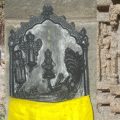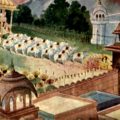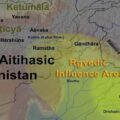Is Kohinoor Diamond the Syamantaka of Mahabharat Era? An Analysis
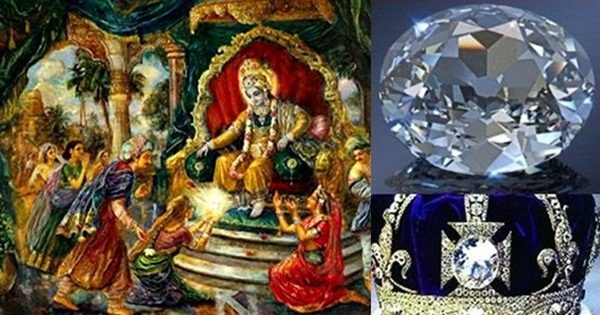
The colorless Kohinoor diamond has been the subject of discussion and prized possession for several dynasties for many centuries. It has been fittingly called ‘the King of Diamonds and the Diamond of Kings’. It was never bought or sold. Over centuries, dating back to thousands of years, its possession has been linked with the Royalty. It was the cause of the rise and fall of many kingdoms and also resulted in the murder of kings and maneuverings at royal courts.
What was the weight of the Kohinoor diamond? To quote from Maharaja Duleep Singh – The King in Exile, “The weight of this fabulous gem the ‘Koh-i-Noor’ in the Indian cutting was 186-1/16 of the old carats (191.10 metric carats), but after it had been re-cut in London in 1852 A.D. the weight was reduced to 108-1/3 metric carats. After re- cut, the Koh-i-Noor now weighed 108.93 carats, having lost 43 percent of its original weight.”
Few historians trace the antiquity of the Kohinoor diamond to the pre-Mahabharata times. The History of Koh-I-Noor by NB Sen describes how this gemstone was known as Samantick-Mani (Syamantaka mani) citing reference of it from the Vishnu Purana and Bhagwat Parana. NB Sen provides a detailed account how, right from the time of its first owner, it was possessed by rulers of many different dynasties.

Extract from ‘History of Koh-I-Noor’ by NB Sen, 1953.
According to these references by NB Sen, the Kohinoor as Syamantaka mani was first possessed by Satrajit, gifted to him by Suryadev. To quote from Blue Vanquisher by Manoshi Sinha, “King Satrajit ruled Satrapur, a small neighboring kingdom of Dwarka. To please the Sun God, he did severe penance. The Sun God blessed him by bestowing him with the Syamantaka jewel, which emanated radiance as lustrous as the sun. King Satrajit often wore it as an adornment around his neck.”
The Syamantaka mani then fell in the hands of Jamvavat, then Krishna, Karna, Arjuna, Yudhisthira. One may question how Karna possessed the jewel followed by Arjuna. Krishna owned the mani from Jamvavat, but he did not consider it right to own it. Hence he returned it back to Surya Dev. The Sun God did not keep it and in turn bestowed it on Karna; he was his godfather. During the Mahabharata war, Karna was adorned with numerous jewels and the Syamantaka mani adorned his crown. After Karna was slain by Arjuna in this battle, his armour, crown and weapons fell in the possession of the latter. Thus Arjuna became the owner of the Syamantaka mani. According to another source, the diamond was in the possession of Bhuri Sharava, king of Kashmir before it fell in the hands of the Pandavas. After the Mahabharata war was over and Yudhisthira crowned king, Arjuna gifted the king the mani.
From Yudhisthira, the Syamantaka mani was then in the possession of Parikshit, Arjun’s grandson and then Janmajeya. In later years, it was in the possession of Porus who defeated Alexander. Not much information is available about the kings who possessed the Kohinoor diamond before and after Porus. Ashoka’s grandson Raja Samprati owned it and later by Raja Vikramaditya. Over time the Paramara rulers of the Malwa region possessed it followed by the Kakatiyas of Warangal.
According to another version of the origin of Kohinoor diamond, it originated in the mines of Golconda of the Kakatiya kingdom which finds mention in Secrets of the World’s Undiscovered Treasures by Lionel and Patricia Fanthorpe. But the same book also mentions Kohinoor as the Syamantaka jewel citing Sanskrit records and dating the jewel back to 5000-6000 years. According to few more sources, the Kohinoor diamond was adorned as the left eye of Bhadrakali in a temple in Warangal, the Kakatiya kingdom before it fell in the hands of the Khiljis.
This diamond was also once stored in a vault in the Golconda Fort. This fort with a township within was first built by the Kakatiyas around the 12th century, also rebuilt and strengthened by Rani Rudrama Devi, a Kakatiya queen in 13th century. During ancient and medieval times, Golconda was the market city of the diamond trade! The Kohinoor diamond was never sold.
There have been mixed opinions on the origin of the Syamantaka mani as Kohinoor and its origin in one of the mines of Andhra Pradesh. According to an account by Prof. A.V. Narasimha Murthy, former Head, Department of Ancient History & Archaeology, University of Mysore, Raja Prataparudra and then Rani Rudramadevi of the Kakatiya dynasty owned the Kohinoor diamond. God-fearing, they got the jewel studded in the Moorti of their family deity Goddess Bhadrakali in a temple. According to the same account, Ghiasuddin Tughlaq, the founder of the Tughlaq dynasty, invaded the Kakatiya kingdom, plundered the city and the temple and looted the Kohinoor diamond. To quote Prof. Murthy from his write-up published in Starofmysore: “Kohinoor was one of the largest diamonds in the world then and its weight was 793 carats…..discovered in Guntur district of Andhra Pradesh. The Kakatiya kings with their capital at Warangal (Orugallu) ruled over most parts of Andhra during 1083 to 1323 AD. King Prataparudra and queen Rudramadevi had this diamond. But as they were God-fearing, they adorned Kohinoor on their family Goddess Bhadrakali. Ghayatuddin Tughlaq (1320 AD) invaded the Kakatiya Kingdom and plundered the temple and took away the Kohinoor along with gold and silver.”
K Satyanarayana in A Study of the History and Culture of Andhras describes about Kohinoor being found in Kolluru, part of the Kakatiya kingdom. V. Madhavan, Professor of Geology in Kakatiya University and who has studied diamond mining for nearly six decades said, as quoted in an article by The Hindu that “the Kohinoor was mined by the Kakatiyas when Rani Rudrama Devi headed the kingdom, its headquarters in present day Warangal”. Though the origin and discovery of the Kohinoor is still a mystery, Professor Madhavan is of the opinion that the Kohinoor was mined by the Kakatiyas when Rani Rudrama Devi headed the kingdom.
The Kakatiya kingdom was attacked several times. It was first attacked by Malik Kafur in 1310 under the orders of Alauddin Khilji. Prataparudra II was then the Kakatiya ruler, who defended his territory for four long months till Kafur could enter the gates. The kingdom was attacked again by Ulugh Khan (later christened to Muhammad Bin Tughlaq) under the orders of Ghiasuddin Tughlaq, his father and the Delhi Sultan.
There is another version about the ownership of the Kohinoor in the hands of Alauddin Khilji that finds description in the Baburnamah, Babur’s biography though it directly doesn’t find mention of Kohinoor. If the diamond mentioned is Kohinoor, it may be plausible that it was Malik Kafur not Muhammad Bin Tughlaq who looted the Kohinoor and gave to Alauddin Khilji. The Baburnamah mentions a probability of Alauddin Khilji gaining the diamond from a Hindu ruler of Malwa, but this claim is without any credibility. Or it may be true, going by the account of NB Sen that the Malwa ruler held it in possession after which it fell in the hands of the Kakatiyas followed by Alauddin Khilji. The Baburnamah describes the diamond thus: “…not let them go. They made him a voluntary offering of a mass of jewels and valuables amongst which was the famous diamond which Alau’u’d-dm must have brought. Its reputation is that every appraiser has estimated its value at two and a half days’ food for the whole world. Apparently it weighs 8 miskels.” One miskel is equal to 4.25 grams. Here is an extract from the Baburnamah:
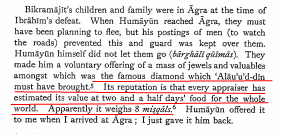 There is another version of the origin of the Kohinoor diamond by Satwinder Kaur, Assistant Professor in History, Swift Technical Campus, Punjab. Besides citing its origin to the Mahabharata era, she also delves thus in a journal article titled – ‘Koh-I-Noor Mountain of Light’ published in International Journal of Science and Research (IJSR), “Another source claims that the diamond was discovered in a river bed in 3200 B.C Historical evidence suggests that the Kohinoor originated in the Golconda kingdom, in the south Indian state of Andhra Pradesh, one of the world’s earliest diamond producing regions. This region was the first and only known source for diamonds until 1730 when diamonds were discovered in Brazil. The term ‘Golconda’ diamond has come to define diamonds of the finest white colour, clarity and transparency. They are very rare and highly sought after.”
There is another version of the origin of the Kohinoor diamond by Satwinder Kaur, Assistant Professor in History, Swift Technical Campus, Punjab. Besides citing its origin to the Mahabharata era, she also delves thus in a journal article titled – ‘Koh-I-Noor Mountain of Light’ published in International Journal of Science and Research (IJSR), “Another source claims that the diamond was discovered in a river bed in 3200 B.C Historical evidence suggests that the Kohinoor originated in the Golconda kingdom, in the south Indian state of Andhra Pradesh, one of the world’s earliest diamond producing regions. This region was the first and only known source for diamonds until 1730 when diamonds were discovered in Brazil. The term ‘Golconda’ diamond has come to define diamonds of the finest white colour, clarity and transparency. They are very rare and highly sought after.”
If we go by the accounts that Malik Kafur plundered Warangal and took the Kohinoor from the Kakatiyas and gave to Alauddin Khilji in 1310, it later fell in the hands of successive Islamic rulers of Delhi. After Khilji, the Kohinoor fell in the hands of Babur. All the Mughal rulers boasted of this prized possession. Shah Jahan adorned it on his peacock throne to get in it a reflection of the Taj Mahal. Persian invader Nadir Shah treacherously took the Kohinoor diamond from Muhammad Shah, the grandson of Aurangzeb. From Nadir Shah, it fell in the hands of Ahmad Shah Abdali in Afghanistan. Shah Shuja Durrani, Abdali’s descendant, possessed the diamond. He was ousted from the throne of Afghanistan by Mahmud Shah and sent to exile and was imprisoned in Attock of Punjab province and later Kashmir. Shah Shuja was forced to give the Kohinoor diamond to Maharaja Ranjit Singh in 1813 or 1814.
That’s how, after several centuries in the hands of Islamic invaders and rulers, the Kohinoor diamond, which had become a symbol of the might and stability of an empire/dynasty, finally fell in the hands of Ranjit Singh. It adorned the Maharaja’s crown and then studded in his armlet. Ranjit Singh made a Will that after his death, the Kohinoor diamond be donated to Jaggannath Temple of Puri.
According to the book History of Koh-i-noor by NB Sen, first published in 1953, Maharaja Ranjit Singh, before his death in 1839 wished that the Kohinoor diamond be sent to Jagannath Temple Puri. It was a suggestion made by the Royal priest who foresaw that the diamond might have caused the king to fall ill and that the gemstone should be adorned in a temple. But the king’s Sardars refused. Had the diamond been sent then, it would not have fallen into British hands. To quote NB Sen from this book: “Just before his death, Maharaja Ranjit Singh directed that the Koh-i-Noor be sent down to the Temple of Jagannath at Puri. But his Sirdars refused on the grounds that not such another diamond in the world existed and that the whole wealth of India could not purchase it. Had the needful been done at that time, the history of the Koh-i-Noor in later years would have been quite different.” Here is an extract from NB Sen’s book:
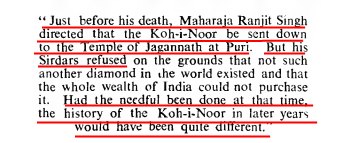
The Sikhs have a connection with Jaggannath Puri. One of the five warriors – the Panj Pyare initiated by Guru Govind Singh for defending Dharma and the motherland from Islamic invaders, was from Jggannath Puri. He was Himmat Rai, a water carrier from Jheeaur clan. He was initiated as Bhai Himmat Singh to the Panj Pyare. He, an ordinary man, thus became a Kshatriya, to save the motherland. He attained martyrdom at the Battle of Chamkaur at age 44. Here is an extract from the book Guru Gobind Singh and Creation of Khalsa by Prof. Madanjit Kaur on the initiation of one of the Panj Pyare from Jagannath Puri:
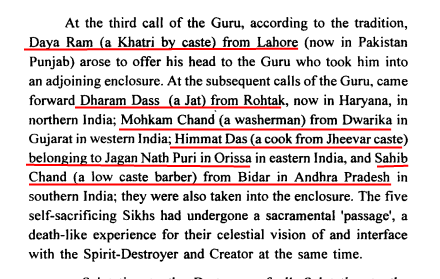
According to another version from the same book by NB Sen, Maharaja Ranjit Singh fell very ill. He then wished that the Kohinoor diamond be sent to Jagannath temple Puri. But one of the Sardars Missar Beli Ram refused.
More sources say one of the sardars of Maharaja Ranjit Singh was on his way to Jaggannath temple in Puri with the Kohinoor diamond and more jewels upon the orders of the Emperor. The Maharaja was then ailing and bedridden. Halfway news about the death of the Maharaja reached the Sardar’s ears. He did not continue his journey to Puri and returned to the Sikh kingdom, kept the jewels and delivered the Kohinoor diamond to the successor of the Maharaja. But all of these accounts are based on one truth whether or not Maharaja Ranjit Singh made a Will – that he wanted the Kohinoor diamond to be donated to Jaggannath temple Puri.
After the death of Maharaja Ranjit Singh, there was continuous chaos for rulership leading to murders of whoever ascended the throne. The Kohinoor was already in the custody of Missar Beli Bam, who was in charge of the Tosha Khana and then under Dhian Singh, the Prime Minister. Dhian Singh also got murdered and the Kohinoor remained in custody of his brother Gulab Singh who in turn presented it to Maharaja Sher Singh at the time of his coronation. Thereafter, it remained in the possession of infant Maharaja Daleep Singh. The king was young and there was in-fighting amongst the nobility of the royal court. After the Second Anglo-Sikh war wherein the British won, Punjab was annexed into the British empire and the Kohinoor was ceded to Queen Victoria. It was the year 1849.
With a history of bad luck associated with male rulers who wore the Kohinoor, upon arrival in the UK, it was worn only by female members. Queen Victoria wore the diamond in a brooch and a circlet. After Victoria’s death, it adorned the crown of Queen Alexandra and then the crown of Queen Mary. Finally, it adorned the crown of Queen Elizabeth. At present, the Kohinoor diamond is on public display in the Jewel House at the Tower of London.
So, who is the rightful owner of the Kohinoor diamond? Obviously India! But the origin is still a mystery. If it is the Syamantaka mani, as claimed by many historians and scholars, it would date back to thousands of years. If it is discovered in the mines of Andhra Pradesh, the then Kakatiya kingdom, then it is at least 1700 years old. But the mystery of its antiquity still remains.
Ref:
1. ‘History of Koh-I-Noor‘ by NB Sen, 1953.
2. Maharaja Duleep Singh – The King in Exile.
3. Baburnamah, Babur; translated by Annette Susannah Beveridge.
3. Blue Vanquisher by Manoshi Sinha.
4. Saffron Swords by Manoshi Sinha and Yogaditya Singh Rawal.
Featured image source/courtesy: Google.

